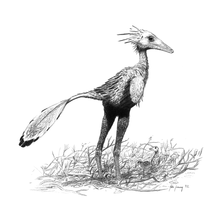Sinornithoides
| Sinornithoides | |
|---|---|

| |
| Fossil | |
| Scientific classification | |
| Domain: | Eukaryota |
| Kingdom: | Animalia |
| Phylum: | Chordata |
| Clade: | Dinosauria |
| Clade: | Saurischia |
| Clade: | Theropoda |
| Family: | †Troodontidae |
| Genus: | †Sinornithoides Russell & Dong, 1993 |
| Species: | †S. youngi
|
| Binomial name | |
| †Sinornithoides youngi Russell & Dong, 1993
| |
Sinornithoides (meaning "Chinese bird form") is a
Discovery

In 1988, a Chinese-Canadian expedition discovered the remains of a small theropod near
It is represented by a
Description

Sinornithoides is a

In 1994, Sinornithoides was one of the most completely known troodontids, especially as regarded the palate, but the lack of sufficient fossil material to compare it with induced Russell and Dong not to indicate any diagnostic traits.[2]
The skull of Sinornithoides is elongated and pointed. However, the head is relatively short compared to the body as a whole. The
Classification
Sinornithoides was in 1994 assigned to the Troodontidae.[2]
A possible position of Sinornithoides in the evolutionary tree of the Paraves is shown by the cladogram below, following a 2012 analysis by Turner, Makovicky and Norell.[6]
| Paraves |
| ||||||||||||||||||||||||||||||||||||||||||||||||||||||||||||||||||||||||||||||
See also
References
- ^ Sereno, P.C. (2010). "Taxonomy, cranial morphology, and relationships of parrot-beaked dinosaurs (Ceratopsia: Psittacosaurus)." New Perspectives on Horned Dinosaurs. Bloomington: Indiana, 21-58.
- ^ a b c d Russell, D. and Dong, Z. (1993). "A nearly complete skeleton of a new troodontid dinosaur from the Early Cretaceous of the Ordos Basin, Inner Mongolia, People's Republic of China." Canadian Journal of Earth Sciences, 30: 2163-2173. doi:10.1139/e93-187
- .
- ^ Paul, G.S., 2010, The Princeton Field Guide to Dinosaurs, Princeton University Press p. 139
- S2CID 83572446.
